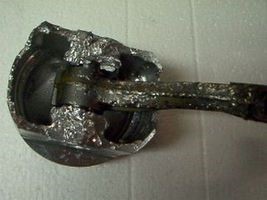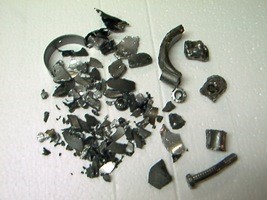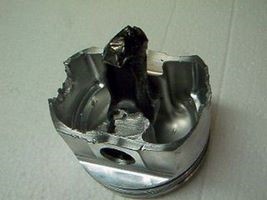THUNDER RUT
A story about grenading an engine

I was Edmonton on June 26 for the Ford 5.0 Shoot-Out, sponsored by JB Automotive and The Edmonton Sun. I expected to clean up. Instead, Labatt Freeway personnel had to clean up after me! The day started off bad and that should have been treated as an omen. Getting up at 5 AM is bad enough, but not finding a place open that sells Egg-McMuffins makes it even worse! The night before my pit-crew decided not to come out with me, so I had to go alone. When I got to the track I noticed a semi-flat slick so I pulled out my little air compressor but it didn't work because it had gotten wet and rusty. Luckily I was able to borrow a fellow racer's. Since I don't have an alternator in my race car, I have to charge the battery with a battery charger through an inverter hooked up to my truck. Well the charger decided to pack it in too! Fortunately I had booster cables, so I hooked the battery up to my truck and kept it charged this way.
I won my first two qualifying runs, with not the best times, but pretty decent,
considering my first time out after fixing the things that broke in previous races.
Just before the elimination round I decided to change my timing a bit (from 42 to 40 degrees- not a major thing) and noticed the car was hard to turn over: the engine started but only with difficulty. This should have been my clue NOT to proceed, because with a fully charged battery and a cool engine, there should not have been turnover problems. I started the car, let it warm up, then proceeded to the staging lanes.
As I approached the Christmas Tree, I noticed the engine temperatur rising quickly, but figured once I headed down the track that the temperature would drop. Second clue. Second mistake. Jim Bell himself (Mr. JB Automotive) was in the other lane and I wanted to whip his butt, so I ignored my own best advice.
I hit the throttle, the engine bogged, picked up, then just quit with a little bit of a pop. (The car is so loud that I didn't hear what MUST have been more than just a "pop") Stalled. Dead. I looked in my mirror but couldn't see where I'd been because of the incredible trail of smoke behind me. This is usually a bad thing. I pulled off to the side, looked under the car and saw oil dripping and burning off my headers. Very quickly I was surrounded by track personnel who helped me assess the situation and thanked me for driving off to the side of the track, keeping the track clean. I thought I should have won a trophy just for that fine deed, but they weren't biting. (When Barbara asked if I jumped out of the car as soon as I saw the smoke I said "no, I wanted to burn with her." I wasn't going to abandon my baby in her time of need!)
Back in the pits (Now I know why they call it that), I looked closer at the engine and the
source of the oil and found it to be coming from holes in the oil pan, put there by an
errant connecting rod. I blew the motor. A $15,000 motor.
I put the car on the trailer and watched some of the eliminations, listing off who I could
have beat, then left before it was all over. I've got work to do.

I took one week of "emergency" holidays
starting the next day so I could pull the engine,
which I did in the comfort of my garage,
having moved the convertible to off-site
storage. I dismantled the engine and was not
pleased (what an understatement) with what I
saw: broken rods, pistons and engine block. I
knew most of it was scrap iron at this point but
thought I'd get an expert opinion and brought
the parts to two race-engine builders. They
didn't exactly concur; whereas I thought most of it was junk, they both said that all of it
was junk! The block, the crank, the cam, pushrods, all scrap iron. I was able to save
the pair of $5000 Trick Flow Twisted Wedge Race heads though. Six pistons
survived but they were specially designed for the engine, so they may as well be
called scrap as well.


What did the experts say? Well, it had nothing
to do with my little timing change, which I
knew, but had to defend to idiots that didn't
know anything about engines. The engine
heating up quickly was a symptom of a lot of
friction and the analysis of the engine
indicated that a rod bearing had spun in the
cap. From there the engine was on a path to
destruction and just idling it would have seized
it up. The spun bearing was due to rod stretch,
a consequence of too high rpm for the rods used.
I was assured by the engine builder that the
engine could rev to 9500 rpm. Ha! The engine
guys said that guy was smoking something funny
to even think that old Boss engine rods could
survive that kind of rpm. When the engine let go, I
had just shifted out of first gear, at about 8300
rpm, the peak of the power curve, but the damage
had already been done. The heat and the spun
bearing was just too much to bear (no pun
intended) and one rod broke in half, then flailed around in the bottom of the engine at
8300 rpm. The pan was full of shrapnel, hence the expression "grenaded engine".